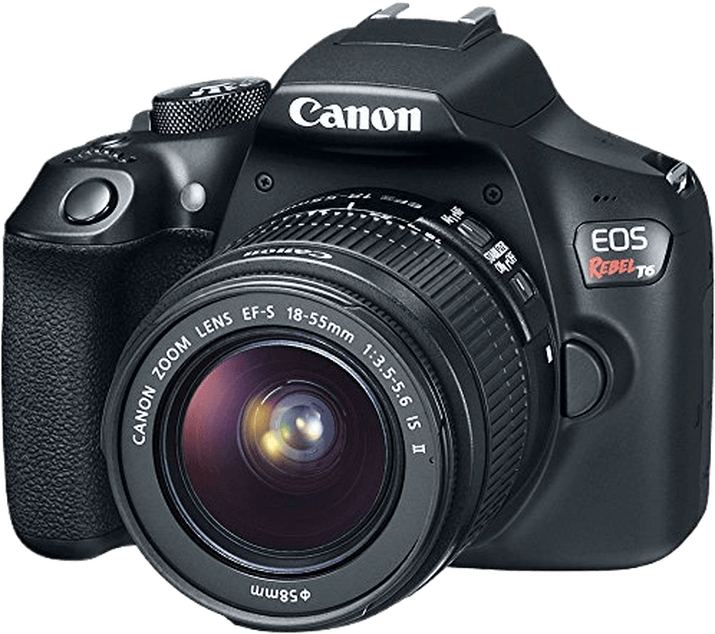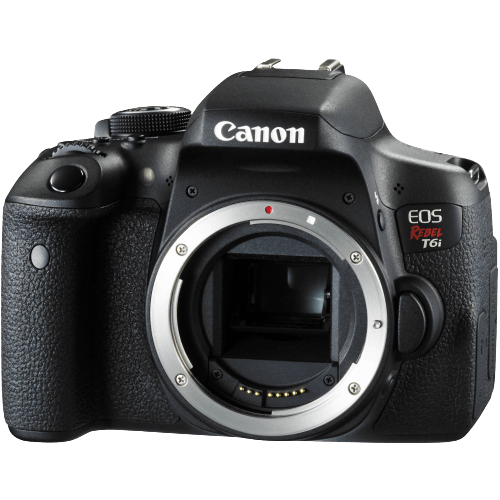Canon EOS Rebel T6 / 1300D vs EOS Rebel T6i / 750D Comparison
Canon EOS Rebel T6 / 1300D

Canon EOS Rebel T6i / 750D

The Canon EOS Rebel T6i / 750D emerges as the winner with a score of 56/100, outperforming the Canon EOS Rebel T6 / 1300D, which scored 39/100. Both cameras are DSLRs and were released in 2015 and 2016, respectively. They share similar dimensions, with the T6i being slightly larger and heavier. The T6i launched at a higher price of $750 compared to the T6’s $550.
The T6i’s higher score signifies better performance and features. However, the T6 has its advantages, such as being lighter and more affordable. When considering these cameras, one must weigh the benefits of the T6i’s superior performance against the T6’s lower price and lighter weight. Ultimately, the choice depends on individual preferences and priorities.
Canon EOS Rebel T6 / 1300D vs EOS Rebel T6i / 750D Overview and Optics
The Canon EOS Rebel T6i / 750D emerges as the winner in the optics comparison with a score of 59/100, a 19-point lead over the Canon EOS Rebel T6 / 1300D, which scored 40/100. Both cameras share some common specifications, such as the CMOS sensor type, APS-C sensor size, Canon EF-S lens mount, and the absence of image stabilization.
The T6i / 750D outperforms the T6 / 1300D in several areas. With 24.2 megapixels, it offers higher resolution than the T6 / 1300D’s 18 megapixels, enabling more detailed and sharper images. The T6i / 750D also has a faster shooting speed at 5 frames per second, compared to the T6 / 1300D’s 3 frames per second. This better shooting speed allows for improved performance in capturing fast-moving subjects. Furthermore, the T6i / 750D boasts a superior processor, the DIGIC 6, which contributes to better image quality and faster processing times compared to the DIGIC 4+ found in the T6 / 1300D. Lastly, the T6i / 750D’s DXOMARK sensor score of 71 surpasses the T6 / 1300D’s score of 66, indicating improved overall sensor performance.
On the other hand, the T6 / 1300D does not offer any significant advantages over the T6i / 750D in terms of optics. As a result, the T6i / 750D is the clear choice for those seeking superior image quality and performance.
Taking all these factors into account, it is evident that the Canon EOS Rebel T6i / 750D offers better optics than the Canon EOS Rebel T6 / 1300D. The higher resolution, faster shooting speed, better processor, and improved sensor performance make the T6i / 750D a more capable camera for capturing high-quality images.
Canon EOS Rebel T6 / 1300D vs EOS Rebel T6i / 750D Video Performance
The Canon EOS Rebel T6i / 750D and Canon EOS Rebel T6 / 1300D both have a video score of 43/100, indicating that their video capabilities are quite similar. In terms of specifications, both cameras share common features such as Full HD video resolution, maximum video dimensions of 1920 x 1080, and a maximum video frame rate of 30fps. Neither camera has built-in time-lapse functionality.
Despite the shared video score, the Canon EOS Rebel T6i / 750D offers some advantages over the Canon EOS Rebel T6 / 1300D. The T6i / 750D has a more advanced autofocus system, which is crucial for achieving sharp and accurate focus during video recording. Additionally, the T6i / 750D has a higher resolution articulated touchscreen, which allows for easier and more precise control when framing and reviewing videos. This makes the T6i / 750D a better choice for those looking to capture high-quality video content.
On the other hand, the Canon EOS Rebel T6 / 1300D has a lower price point, making it more accessible for those on a budget. However, the lower price does not translate to better video performance, as the video specifications remain the same as the T6i / 750D.
In comparing the two cameras, the Canon EOS Rebel T6i / 750D is the better choice for those prioritizing video capabilities, offering a more advanced autofocus system and a higher resolution articulated touchscreen for easier control. The Canon EOS Rebel T6 / 1300D, while more budget-friendly, does not offer any additional video advantages over the T6i / 750D.
Canon EOS Rebel T6 / 1300D vs EOS Rebel T6i / 750D Features and Benefits
The Canon EOS Rebel T6i / 750D outperforms the Canon EOS Rebel T6 / 1300D, scoring 57/100 in features compared to the T6’s 41/100. Both cameras share some common specifications, such as a 3-inch screen size, the absence of GPS, and the inclusion of WIFI connectivity. Neither camera has Bluetooth capabilities.
The T6i / 750D is superior in screen resolution with 1,040,000 dots, compared to the T6 / 1300D’s 920,000 dots. This higher resolution results in a sharper and clearer display. Furthermore, the T6i / 750D has a touchscreen, which makes navigating menus and selecting focus points easier and more intuitive. Both cameras have a flip screen, offering flexibility in shooting angles.
The T6 / 1300D has no specific advantages over the T6i / 750D in terms of features. However, it may be more affordable, making it an option for those on a tighter budget. The T6i / 750D’s higher feature score does not make it a better camera, but it is a better camera due to its improved specifications.
Considering the specifications, the Canon EOS Rebel T6i / 750D is the better choice for those seeking higher screen resolution and a touchscreen. The Canon EOS Rebel T6 / 1300D may be a suitable option for budget-conscious buyers, but it lacks the advanced features found in the T6i / 750D.
Canon EOS Rebel T6 / 1300D vs EOS Rebel T6i / 750D Storage and Battery
The Canon EOS Rebel T6 / 1300D wins in the storage and battery category, scoring 27/100, while the Canon EOS Rebel T6i / 750D scores 24/100. Both cameras have one memory card slot and accept SD, SDHC, and SDXC memory cards. However, the T6i / 750D is also compatible with UHS-I cards, providing faster read and write speeds.
The T6 / 1300D has a longer battery life, allowing for 500 shots per charge, compared to the T6i / 750D’s 440 shots. The T6 / 1300D uses the LP-E10 battery type, while the T6i / 750D uses the LP-E17 battery. Neither camera offers USB charging.
The T6 / 1300D’s longer battery life makes it more suitable for extended shooting sessions, while the T6i / 750D’s UHS-I compatibility offers faster performance with compatible memory cards. However, both cameras lack USB charging, which could be a drawback for some users. The T6 / 1300D’s advantage in battery life outweighs the T6i / 750D’s faster memory card compatibility, making it the better choice in this category.
Canon EOS Rebel T6 / 1300D vs EOS Rebel T6i / 750D Alternatives
Need some more inspiration? Try these related camera comparisons too:
